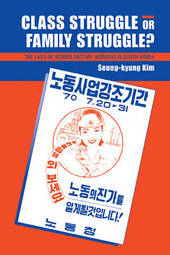
|
Class Struggle or Family Struggle?: The Lives of Women Factory Workers in South Korea
Paperback / softback
Main Details
| Title |
Class Struggle or Family Struggle?: The Lives of Women Factory Workers in South Korea
|
| Authors and Contributors |
By (author) Seung-kyung Kim
|
| Physical Properties |
| Format:Paperback / softback | | Pages:236 | | Dimensions(mm): Height 229,Width 152 |
|
| Category/Genre | Development economics |
|---|
| ISBN/Barcode |
9780521114653
|
| Classifications | Dewey:305.52095195 |
|---|
| Audience | | Professional & Vocational | |
|---|
| Illustrations |
1 Halftones, unspecified; 2 Line drawings, unspecified
|
|
Publishing Details |
| Publisher |
Cambridge University Press
|
| Imprint |
Cambridge University Press
|
| Publication Date |
25 June 2009 |
| Publication Country |
United Kingdom
|
Description
This study complements the burgeoning literature on South Korean economic development by considering it from the perspective of young female factory workers. In approaching development from this position, Kim explores the opportunity and exploitation that development has presented to female workers and humanizes the notion of the 'Korean economic miracle' by examining its impact on their lives. Kim looks at the conflicts and ambivalences of young women as they participate in the industrial work force and simultaneously grapple with defining their roles in respect to marriage and motherhood within conventional family structures. The book explores the women's individual and collective struggles to improve their positions and examines their links with other political forces within the labor movement. She analyses how female workers envision their place in society, how they cope with economic and social marginalisation in their daily lives, and how they develop strategies for a better future.
Reviews' ... The strength of this book lies in the way Kim inter-relates discussions of global and national political-economic context, class, and gender with individual experience and identity. This is how good research and writing on the anthropology of work should be done ... a clearly written, sophisticated, and critical yet sensitive portrayal. It will be of use to readers interested in the gender and class nature of the work experiences and labour activism of South Korean women and, more broadly, to readers interested in the anthropology of women's work in industrial settings in Asia and throughout the global capitalist system.' Anthropology of Work Review
|